

Manifesto for Agile Software Development. Scrum Guides. This HTML version of the Scrum Guide is a direct port of the July 2013 version available as a PDF here.
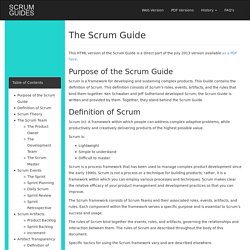
Purpose of the Scrum Guide Scrum is a framework for developing and sustaining complex products. This Guide contains the definition of Scrum. This definition consists of Scrum’s roles, events, artifacts, and the rules that bind them together. Ken Schwaber and Jeff Sutherland developed Scrum; the Scrum Guide is written and provided by them. Definition of Scrum Scrum (n): A framework within which people can address complex adaptive problems, while productively and creatively delivering products of the highest possible value.
Agile software development. Agile software development is a set of principles for software development in which requirements and solutions evolve through collaboration between self-organizing,[1] cross-functional teams.
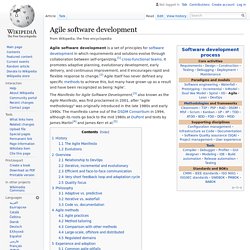
It promotes adaptive planning, evolutionary development, early delivery, and continuous improvement, and it encourages rapid and flexible response to change.[2] Agile itself has never defined any specific methods to achieve this, but many have grown up as a result and have been recognized as being 'Agile'. The Manifesto for Agile Software Development,[3] also known as the Agile Manifesto, was first proclaimed in 2001, after "agile methodology" was originally introduced in the late 1980s and early 1990s. The manifesto came out of the DSDM Consortium in 1994, although its roots go back to the mid 1980s at DuPont and texts by James Martin[4] and James Kerr et al.[5] History[edit] Incremental software development methods trace back to 1957.[6] In 1974, E.
Méthode agile. Certaines informations figurant dans cet article ou cette section devraient être mieux reliées aux sources mentionnées dans les sections « Bibliographie », « Sources » ou « Liens externes »(janvier 2013).
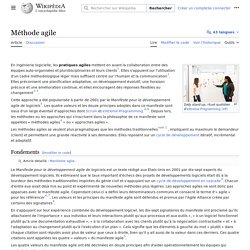
Améliorez sa vérifiabilité en les associant par des références à l'aide d'appels de notes. En ingénierie logicielle, les pratiques agiles mettent en avant la collaboration entre des équipes auto-organisées et pluridisciplinaires et leurs clients[1]. Elles s'appuient sur l'utilisation d'un cadre méthodologique léger mais suffisant centré sur l'humain et la communication[2]. Agile Is Dead (Long Live Agility) - PragDave. Thirteen years ago, I was among seventeen middle-aged white guys who gathered at Snowbird, Utah.
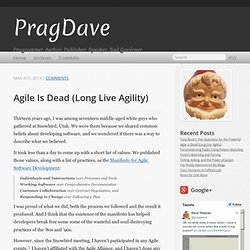
We were there because we shared common beliefs about developing software, and we wondered if there was a way to describe what we believed. It took less than a day to come up with a short list of values. We published those values, along with a list of practices, as the Manifesto for Agile Software Development: Individuals and Interactions over Processes and ToolsWorking Software over Comprehensive DocumentationCustomer Collaboration over Contract Negotiation, andResponding to Change over Following a Plan I was proud of what we did, both the process we followed and the result it produced. However, since the Snowbird meeting, I haven’t participated in any Agile events,1 I haven’t affiliated with the Agile Alliance, and I haven’t done any “agile” consultancy. Why? And, unfortunately, I think time has proven me right. Agile in the enterprise: To succeed, avoid the fundamentalists. I remember it as though it were just months ago, but it was early 2005 when a heated discussion rippled across our company.

A new way to develop software had matured and had been growing fast since 2001: the agile software development approach. We knew that it would disrupt the very controlled way CI&T had been developing custom software for big companies for over 6 years, and that was scary. Until then, we were exclusively implementing a formal process called RUP (rational unified process), a successful implementation of the ideas from the unified process framework. In our pitch we were purposely fighting the waterfall method that had been eroding the reputation of software houses over time. Studies were consistently showing that more than 65 percent of big software projects would fail. Today, it comes without a single sign of pain to say that 100 percent of our projects are carried out using agile, but during that time we were uncertain about the future. 1. 2. 3. 4.
Lean for Business. KanbanFlow - Lean project management, simplified.
Petit guide du novice – Vocabulaire – Scrum Saguenay. Depuis quelques chroniques j’utilise plusieurs termes Scrum sans les avoir expliqués.
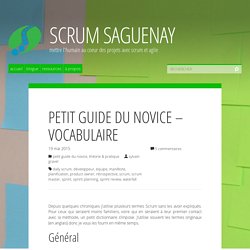
Pour ceux qui seraient moins familiers, voire qui en seraient à leur premier contact avec la méthode, un petit dictionnaire s’impose. J’utilise souvent les termes originaux (en anglais) donc je vous les fourni en même temps. Général D’abord quelques termes généraux : Promoteur (Stakeholder) : Le promoteur est le commanditaire du projet, celui qui le finance et qui en a la vision. Les artéfacts On définit par artéfact tout outil aidant à la planification, la gestion et le suivi sous Scrum.
Récit utilisateur (User Story) : Une User Story (je n’utiliserai jamais le terme français en passant!) L’équipe et les rôles Scrum définit seulement trois rôles dans l’équipe : Propriétaire du produit (Product Owner ou PO) : Le Product Owner est le représentant du promoteur au sein de l’équipe.